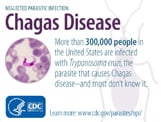Diagnosis
Acute infections can be diagnosed by parasitologic methods, including identification of trypomastigotes in blood by microscopy. Circulating parasite levels decrease rapidly within a few months and are undetectable by most methods during the chronic phase.
Diagnosis of chronic Chagas disease is made by serologic tests for antibody to the parasite. A single test is not sufficiently sensitive and specific to make the diagnosis. For this reason, the standard approach is to apply two or more tests that use different techniques and that detect antibodies to different antigens. Commonly used techniques include enzyme-linked immunosorbent assay (ELISA) and immunofluorescent antibody test (IFA). Careful consideration of the patient’s history to identify possible risks for infection may be helpful.
In December 2006, the U.S. Food and Drug Administration (FDA) approved the first screening test for blood donations and many blood collection agencies started screening blood donations for serologic evidence of Trypanosoma cruzi infection. In 2010, a second screening test made by another manufacturer was approved. A supplemental or confirmatory tests was also approved. Donors are contacted by the blood center and notified about the results of the blood donation testing and positive donors are encouraged to contact their health-care provider for evaluation. Blood donor screening tests are not appropriate for clinical diagnostic purposes and additional testing is indicated. Donors who are positive on the screening test and the supplemental test can no longer donate blood, regardless of any additional testing result. In 2017, FDA issued new guidance about how donors who tested false positive on a screening test can be evaluated to see if they are eligible to donate blood again. Donors who have discordant test results should contact the blood bank regarding this evaluation.
For questions regarding diagnostic considerations, contact CDC’s Parasitic Diseases Inquiries (404-718-4745; e-mail chagas@cdc.gov).
More on: Chagas Disease Diagnosis [DPDx]
